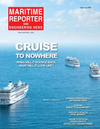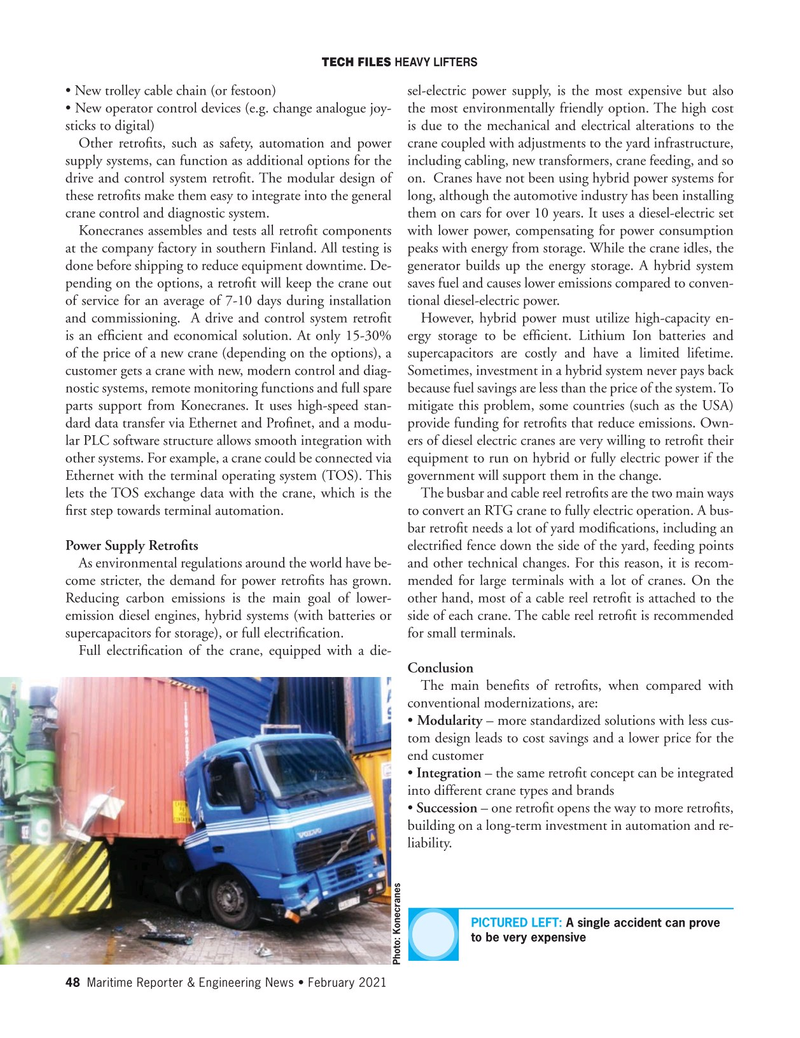
Page 48: of Maritime Reporter Magazine (February 2021)
Government Shipbuilding
Read this page in Pdf, Flash or Html5 edition of February 2021 Maritime Reporter Magazine
TECH FILES HEAVY LIFTERS • New trolley cable chain (or festoon) sel-electric power supply, is the most expensive but also • New operator control devices (e.g. change analogue joy- the most environmentally friendly option. The high cost sticks to digital) is due to the mechanical and electrical alterations to the
Other retro? ts, such as safety, automation and power crane coupled with adjustments to the yard infrastructure, supply systems, can function as additional options for the including cabling, new transformers, crane feeding, and so drive and control system retro? t. The modular design of on. Cranes have not been using hybrid power systems for these retro? ts make them easy to integrate into the general long, although the automotive industry has been installing crane control and diagnostic system. them on cars for over 10 years. It uses a diesel-electric set
Konecranes assembles and tests all retro? t components with lower power, compensating for power consumption at the company factory in southern Finland. All testing is peaks with energy from storage. While the crane idles, the done before shipping to reduce equipment downtime. De- generator builds up the energy storage. A hybrid system pending on the options, a retro? t will keep the crane out saves fuel and causes lower emissions compared to conven- of service for an average of 7-10 days during installation tional diesel-electric power. and commissioning. A drive and control system retro? t However, hybrid power must utilize high-capacity en- is an ef? cient and economical solution. At only 15-30% ergy storage to be ef? cient. Lithium Ion batteries and of the price of a new crane (depending on the options), a supercapacitors are costly and have a limited lifetime. customer gets a crane with new, modern control and diag- Sometimes, investment in a hybrid system never pays back nostic systems, remote monitoring functions and full spare because fuel savings are less than the price of the system. To parts support from Konecranes. It uses high-speed stan- mitigate this problem, some countries (such as the USA) dard data transfer via Ethernet and Pro? net, and a modu- provide funding for retro? ts that reduce emissions. Own- lar PLC software structure allows smooth integration with ers of diesel electric cranes are very willing to retro? t their other systems. For example, a crane could be connected via equipment to run on hybrid or fully electric power if the
Ethernet with the terminal operating system (TOS). This government will support them in the change.
lets the TOS exchange data with the crane, which is the The busbar and cable reel retro? ts are the two main ways ? rst step towards terminal automation. to convert an RTG crane to fully electric operation. A bus- bar retro? t needs a lot of yard modi? cations, including an
Power Supply Retro? ts electri? ed fence down the side of the yard, feeding points
As environmental regulations around the world have be- and other technical changes. For this reason, it is recom- come stricter, the demand for power retro? ts has grown. mended for large terminals with a lot of cranes. On the
Reducing carbon emissions is the main goal of lower- other hand, most of a cable reel retro? t is attached to the emission diesel engines, hybrid systems (with batteries or side of each crane. The cable reel retro? t is recommended supercapacitors for storage), or full electri? cation. for small terminals.
Full electri? cation of the crane, equipped with a die-
Conclusion
The main bene? ts of retro? ts, when compared with conventional modernizations, are: • Modularity – more standardized solutions with less cus- tom design leads to cost savings and a lower price for the end customer • Integration – the same retro? t concept can be integrated into different crane types and brands • Succession – one retro? t opens the way to more retro? ts, building on a long-term investment in automation and re- liability.
PICTURED LEFT: A single accident can prove to be very expensive
Photo: Konecranes 48 Maritime Reporter & Engineering News • February 2021
MR #2 (34-49).indd 48 2/4/2021 10:04:18 AM

 47
47

 49
49
